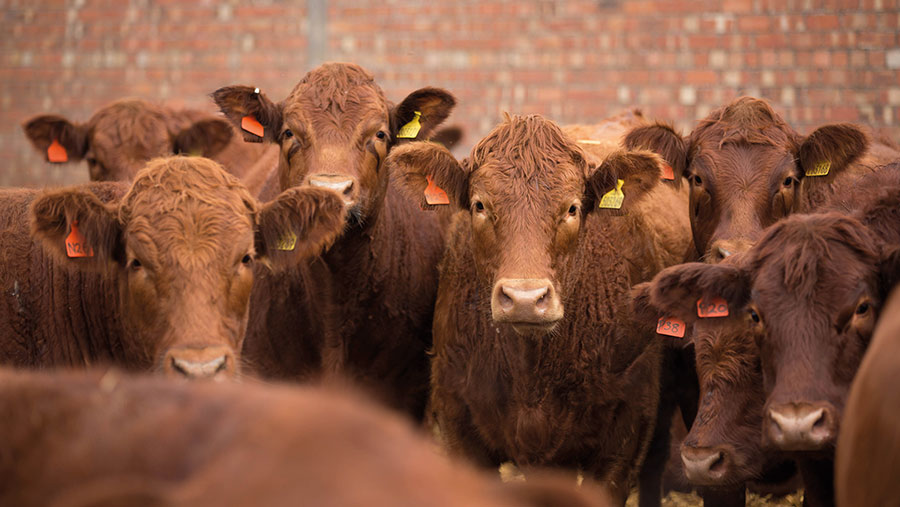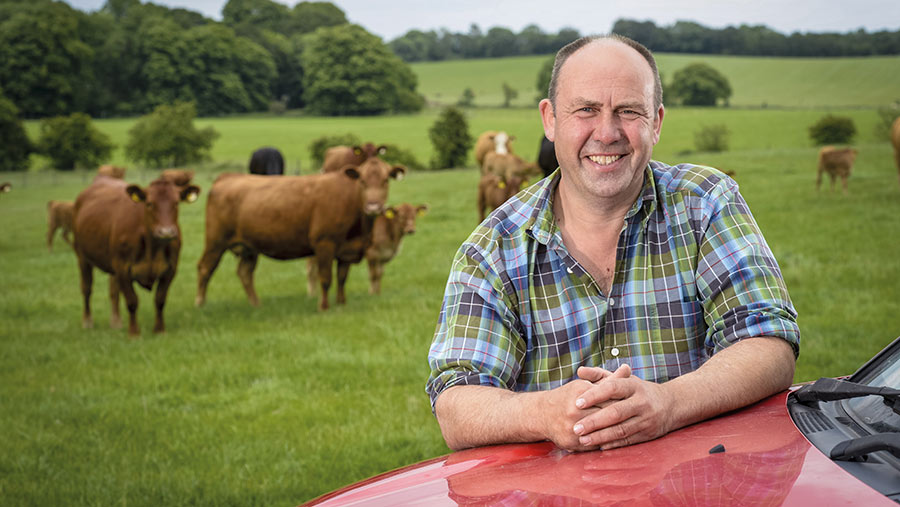4 ways to cut carbon footprint of suckler beef
 © Tim Scrivener
© Tim Scrivener Embracing a combination of cow and youngstock management changes could help suckler herds reduce the carbon footprint of every kilogramme of meat produced.
Ballymena farmer Billy O’Kane recently carried out a carbon audit on his farm (see “Audit highlights carbon accounting challenge”).
Speaking to Farmers Weekly, he explained the four steps he had taken to improve his farm’s carbon credentials.
All the steps have been shown to have a marked effect (see “Impact of example management changes on carbon footprint per kilo of meat”).
See also: 5 tips on selecting and breeding beef replacements
Farm facts
Crebilly Farm, Ballymena, County Antrim
- 202ha (500 acres)
- 230 suckler cows – either pure or part Stabiliser
- Outdoor, spring calving
- Females kept for replacements or sold for breeding
- Calve at 24 months
- Males sold for breeding or finished as bull beef
- Farmers Weekly Beef Farmer of the Year 2014
1. Selecting a smaller cow
Mr O’Kane has switched from running a mix of terminal sire breed cows that required a lot of feeding to the smaller Stabiliser breed.
This has reduced average cow size from 760-780kg to 620kg.
Fifty cows and their offspring are now kept on the same land area that would have kept 40 cows and their offspring.
Weaning and slaughter weights have stayed the same so meat output has increased by about 25%.
“It really helps our carbon footprint per kilo of output. We’re getting a higher production of meat for the same carbon output we used to have,” Mr O’Kane explains.
2. Cows only receive concentrate in their first winter
Cows are only fed concentrate from weaning to turnout in their first winter to help get them on track to calve at 24 months.
This means they receive 300kg of concentrate in their lifetime and are then reliant on home-grown forages.
3. Finishing bull beef
All males are finished as bull beef at an average 14 months old and about 389kg deadweight.
Mr O’Kane believes targeted concentrate use in the finishing period can have a beneficial impact on the farm’s environmental impact because males are sold more quickly.
Bulls receive a total of 1.5t of concentrate a head from six to 14 months of age.
Their feed conversion rate is also more efficient, at 4:1, compared with 10:1 if they were kept until they were more than two years old.
Mr O’Kane added: “Targeting the concentrate strategically to the generations that have the best feed conversion rate has a significant impact on the carbon output per kilo of meat.”
None of the diets includes ingredients from countries practising deforestation, which means no soya or soya hulls are used. Most of the diet is made up of by-products, such as maize distillers.
4. Attention to forage and soils
On the home farm, soils have an organic matter of 15%, almost three times the national average. This is helped by rotational grazing, which means grass growth requires less nitrogen, phosphate and potash.
Fewer inputs mean the financial and carbon cost of growing grass is reduced, Mr O’Kane says.
He has also adopted “a total ban of the plough,” instead using direct-drilling to establish grassland.
This reduces the loss of soil carbon into the atmosphere. White clover also fixes nitrogen and reduces fertiliser requirements.
Impact of example management changes on carbon footprint per kilo of meat |
||||
|
AHDB Stocktake average |
Target |
Impact of reduction on carbon footprint per kilo of meat |
Explanation |
|
|
Cow weight |
750kg |
600kg |
-7.3% |
A smaller cow requires less feed for maintenance and in total |
|
Age at first calving |
36 months |
24 months |
-3.8% |
Fewer unproductive animals carried on farm |
|
Forage fed to cows |
Small amount of concentrate fed |
All forage fed |
3.6% |
Less bought-in concentrate |
|
Days to finish |
24.8 months (females) 23.1 months (steers) |
20 months (females) 18 months (steers) |
-10.1% |
Reduced time on farm requiring less feed and resource use |
|
Days to finish and finish system |
24.8 months (females) 23.1 months (steers) |
20 months (females) 13 months |
16.3% |
Finished sooner as bulls so even less time on farm |
|
Modelling work carried out by the Stabiliser Cattle Company and Alltech E-CO2, presented by Seth Wareing of the Stabiliser Cattle Company at the BCBC conference. The work used average figures from AHDB’s Stocktake and compared them to target figures from the Stabiliser Cattle Company (SCC) based on around 100 UK Stabiliser herds and 12,000 cows |
||||
Audit highlights carbon accounting challenge
A farm carbon audit carried out by Billy O’Kane (pictured) highlighted the huge disparity between auditing methods and the need to accurately account for methane’s environmental impact.

© Jim Varney
Under the GWP100 system, his farm was found to be 54% of the way to becoming carbon neutral.
However, the GWP* system showed the farm was 105% carbon neutral, so it was sequestering 5% more greenhouse gases than it released.
Mr O’Kane said this was because GWP100 – which has been widely used to calculate global figures – over-penalises methane by 3.4-4 times.
GWP* takes into account the fact that methane degrades in the atmosphere and has a half-life of 10 years, whereas carbon dioxide persists in the atmosphere.
Other reasons why less focus should be put on cows and methane and more on carbon dioxide included:
- Carbon dioxide production has increased by 200% in 40 years primarily due to fossil fuels*
- Herbivore origin methane has increased by 6% in 120,000 years**
- 40% of total annual methane comes from animals and nature***
- 60% of methane production is from human activity
Sources:
*US Energy Institute Administration, International Energy Agency and oil exploration mechanical engineer Neil Thompson.
**Exploring the influence of ancient and historic megaherbivore expirations on the global methane budget, Smith, Hammond et al, 2015, Smithsonian Institute and University of Mexico.
***Environmental Change Institute Literature Review
Billy O’Kane presented his case study at the British Cattle Breeders Club conference (25 January).
